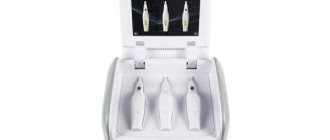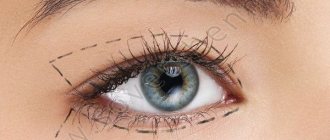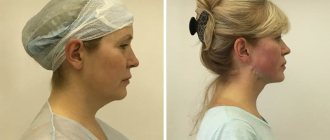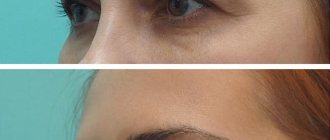Modern medicine has made a huge breakthrough in the field of surgical techniques to visually change any part of the face. One of the most popular procedures is blepharoplasty. It is a plastic surgery aimed at eliminating excess skin and subcutaneous fat around the eyes.
The main goal is to achieve a rejuvenating effect and give the look freshness and openness. Indications:
- Ptosis (drooping) of the upper eyelids as a result of overhanging skin folds.
- Fatty hernias, bruises and swelling (“bags”) under the eyes.
- Medium and deep wrinkles.
Preparation for circumferential blepharoplasty surgery
Before surgical treatment, the surgeon conducts a consultation. At a consultation, the condition of the skin of the upper and lower eyelids and the severity of paraorbital fatty hernias are determined. Depending on the objective data obtained, the optimal surgical treatment option is selected.
If there are no contraindications to eyelid surgery, the surgeon gives recommendations on nutrition and taking medications before surgery. Shortly before eyelid surgery, the doctor recommends stopping drinking alcohol and quit smoking, since these bad habits impair microcirculation and therefore directly affect the healing process. In order for circular blepharoplasty to proceed without complications, a few days before it is performed, you should avoid going to beauty salons, and 8 hours before, from any food and water. Before surgery, the patient also needs to visit an anesthesiologist for consultation.
Main types of operations
During preliminary consultations, the surgeon conducts a comprehensive diagnosis of the eye area, models an approximate result, and shows photos confirming the specialist’s practical experience.
There are several types of plastic surgery depending on the area:
- Blepharoplasty of the lower eyelids. To remove excess skin and lipid hernias, a small incision is made along the edge of the eyelashes. After the capsules are removed and the areas are excised, thin, almost invisible sutures are applied.
- Blepharoplasty of the upper eyelids. The procedure is similar in description to manipulations on the lower ones. The difference is that the cut is made along a natural fold to make it as invisible as possible from the outside.
- Canthoplasty is the correction of the corners of the eyelids using a lift. Allows you to completely change the shape of the eye shape, making your look more expressive.
- Circular or quadrilateral blepharoplasty. Simultaneous plastic surgery of the upper and lower eyelids. It is considered a radical option, especially indicated for people with severe age-related changes, when, in addition to excess skin and fat bags, there are deep furrows, pronounced bulges, and ptosis.
Postoperative period
Recovery after plastic surgery takes up to two weeks. Swelling and redness may occur in the first days. To make them heal faster, it is recommended to apply a healing ointment. During rehabilitation, it is prohibited to use cosmetics and it is necessary to protect yourself from sunlight (wear dark glasses). Subsequently, it is recommended to use sunscreen.
The sutures after blepharoplasty are removed after 3-5 days, but the scar finally heals and becomes invisible after a month and a half.
Medical contraindications
- High blood pressure.
- Dry eye syndrome (keratoconjunctivitis).
- Chronic diseases of the cardiovascular system, diabetes, oncology.
Progress of the operation
Circumferential eyelid surgery is performed in the operating room using intravenous sedation, local anesthesia, or general anesthesia. The choice of anesthesia method depends on the duration of the operation and the scale of the impact. Extended circumferential blepharoplasty can take up to 2 hours and cover a large area, so it is most often performed under general anesthesia.
Before the operation begins, the doctor marks the plastic area and marks the incision lines. Next, using a scalpel or surgical scissors, an incision is made in the folds of the skin so that the postoperative suture is as invisible as possible. After excision of an overly stretched skin fold, the doctor removes subcutaneous fat, excess skin, and, if necessary, the orbicularis oculi muscle, removes or moves them to the nasolacrimal groove (depending on the indications).
Non-surgical eyelid lift using Sublative ELOS technology
We know almost everything about surgical blepharoplasty. But non-surgical eyelid lift using ELOS technologies using the Sublative device is an almost new procedure and very popular. Why is it in demand? Because this is the most gentle and correct method of rejuvenation and non-surgical tightening of eyelid skin in particular and lifting and correction of skin defects in general.
ELOS is a new hardware technology that combines the effects of light energy and radio waves. And it has two great advantages: safety and effectiveness.
The ELOS technology itself is well known and widespread. It was developed and patented by the largest corporation manufacturing medical and cosmetology equipment Syneron-Candela. This equipment is chosen by leading specialists from clinics in the USA, Canada, Israel, and France; Having accumulated significant experience working with ELOS systems, doctors have made their clear conclusions: they can be trusted.
The essence of ELOS rejuvenation is to stimulate the formation of collagen and elastin in the deep layers of the skin. With age, the production of your own collagen and elastin decreases and the skin loses the properties that these proteins provide - firmness and elasticity. It sags, becomes flabby, dry and thin.
• For the ELOS eyelid rejuvenation procedure, no anesthesia is used (a huge advantage of the ELOS system is contact cooling during the procedure); • The lifting procedure is tolerated calmly and comfortably; • Immediately after the procedure, you can apply decorative cosmetics; • But visits to the sauna are excluded!
What you can observe after the procedure:
• Healthy skin color and radiance; • Radiant skin; • Small wrinkles are smoothed out, pigment spots disappear, pores narrow; • Vascular defects go away - angiomas, hemangiomas; • Acne is reduced.
Immediately after the procedure, you can enjoy an improved complexion and a delicate, healthy glow; the skin tightens, its texture improves, you look much younger!
How many procedures will be required?
The entire eyelid lift course requires no more than five to six sessions. Sessions are held once every three weeks. Maintenance courses are prescribed according to indications. You can begin ELOS rejuvenation procedures as early as the age of thirty, when the first wrinkles appear. You can get rid of existing wrinkles and prevent the appearance of new ones.
Rehabilitation
Circumferential blepharoplasty does not require a long hospital stay. As a rule, the patient is allowed to go home literally a few hours after the operation. If there are medical indications, the patient may be left in the clinic for 1-2 days.
For 14 days after surgery, you must remain in bed and do not strain your eyes, otherwise a simple surgical intervention may cause complications. Sutures are removed on the 5th day after plastic surgery. The rehabilitation period takes 2-4 weeks.
To prevent infection from getting into the stitches, the clinic treats the patient’s eyelids daily with antibacterial and disinfectant agents. Touching the operated area is allowed only during treatment; the rest of the time it is not advisable to touch the eyelids with your hands.
Circular blepharoplasty is accompanied by the appearance of edema and hematomas.
The rehabilitation period can be reduced thanks to specially designed recovery programs. During the rehabilitation period, you should not self-medicate. It is best to contact the doctor who performed the eyelid surgery directly with any questions. Share:
How is blepharoplasty surgery performed?
The surgical intervention is performed in our equipped hospital under general anesthesia or combined anesthesia. Its duration ranges from 20 to 50 minutes. If you need to perform manipulation on the upper eyelid, then the incisions are made in its fold, and if on the lower eyelid, then under the eyelash line. By manipulating through these small incisions, the surgeon removes excess fat, restores muscle, and fills in areas of deformity. During the operation, circumferential eyeplasty can also be performed. The doctor then carefully stitches the incisions and applies a bandage. The surgeon applies the sutures very delicately - the very next day they have an aesthetic appearance.
If it is necessary to remove hernias on the lower eyelids, transconjunctival blepharoplasty of the eyelids is prescribed. It can be performed provided the skin is sufficiently elastic and even without incisions. The intervention is performed through the mucous membrane of the lower eyelid. There are no scars or stitches left.
Postoperative period
If the patient feels well and wishes, he can leave the clinic a couple of hours after the operation. However, our experts recommend staying in the hospital for about a day in order to prevent possible complications in time. The sutures are removed 3-4 days after the intervention. Over the next two weeks, the patient should avoid physical activity and sports. A course of restorative procedures in our clinic, developed by practicing surgeons, will help shorten the rehabilitation period.
Outpatient observation lasts approximately 4 weeks. The rehabilitation period takes place individually in each case. Swelling after the manipulations disappears in about a week, bruises within 7-14 days. The full result will appear in 6-8 weeks.
How much does blepharoplasty of the upper and lower eyelids cost?
The cost of the operation is an important factor that pushes many women away from plastic surgery. By contacting the Academy of Plastic Surgery and Cosmetology, you receive high-quality services from surgeons of the highest category with many years of experience, using modern and safe techniques. The price for blepharoplasty is one of the most attractive in Novosibirsk. This is due to the mission of our clinic - to make beauty accessible!
Phone number for registration.
Additional payment is made for the services of an anesthesiologist, repeated examinations and dressings, and medical tests necessary for the operation are also provided separately.
Rehabilitation period
Recovery after laser blepharoplasty lasts several weeks. It is important to follow all the recommendations of your doctor so as not to disrupt the natural regeneration processes.
The ophthalmologist will provide basic data on the course of the rehabilitation period. It is important to follow certain rules and specific restrictions:
- protect facial skin from direct sunlight, dust and various contaminants;
- do not touch your face with your hands, especially in the first days after surgery;
- do not rub the skin with washcloths or hard towels; it is prohibited to use peelings and other aggressive procedures;
- the ban on cosmetics lasts for 10-14 days;
- physical activity is limited for a month.
To monitor your eye condition, it is recommended to visit your doctor on time.
Indications for surgery
Laser blepharoplasty is performed at the request of the patient who wants to get rid of certain defects in appearance. Some of them can even lead to vision impairment. By getting rid of overhanging tissue, it is possible to improve not only the appearance, but also restore impaired visual function.
Main indications for laser blepharoplasty:
- drooping eyelids and corners of the eyes;
- asymmetry of features located in the middle third of the face;
- the presence of bags and hernias under the eyes;
- wrinkles and other age-related changes;
- the patient's desire to change the shape of the eyes.
There are also medical indications for which laser blepharoplasty can be performed. The operation is indicated in the presence of entropion of the eyelids, mechanical damage to the skin and muscles located in the eye area. Blepharoplasty is also performed when the eyeballs protrude excessively forward.
Types of laser blepharoplasty
Depending on the purpose, laser blepharoplasty can be of the following types:
- Blepharoplasty of the upper eyelids. During the operation, excess skin is excised using a laser, the position of the upper eyelid is changed, sagging tissue is tightened and signs of sagging and other age-related changes are eliminated.
- Blepharoplasty of the lower eyelids. The operation involves removing bags under the eyes and fatty hernias.
- Circular blepharoplasty. The operation allows you to eliminate defects in the entire periorbital region.
- Canthopexy. During surgery, a specialist lifts the drooping corners of the eyes, which visually makes the look open, clearer and more youthful.
- Changing the shape of the eyes. The operation allows you to change the shape of the eyes to a more desirable one that suits a specific type of appearance.










